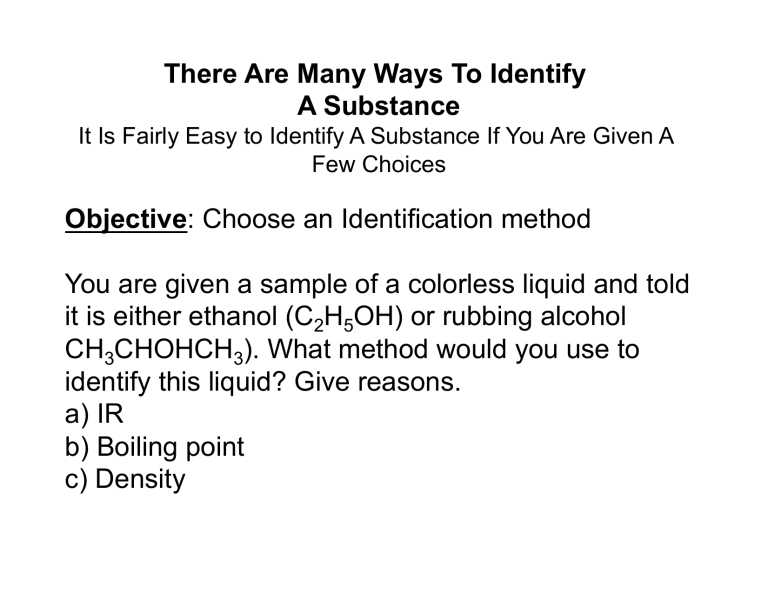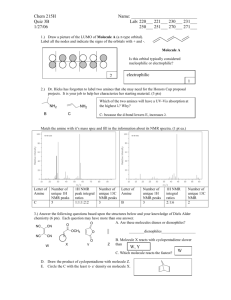CCChemTeach

There Are Many Ways To Identify
A Substance
It Is Fairly Easy to Identify A Substance If You Are Given A
Few Choices
Objective : Choose an Identification method
You are given a sample of a colorless liquid and told it is either ethanol (C
CH
3
CHOHCH
3
2
H
5
OH) or rubbing alcohol
). What method would you use to identify this liquid? Give reasons. a) IR b) Boiling point c) Density
Objective : Choose an Identification method
You are given a sample of a colorless liquid and told it is C
4
H
10
. C
4
H
10
has two isomers. What method would you use to determine which isomer of C you were given? Give reasons.
4
H
10 a) IR b) Boiling point c) Density
To Determine the Structure of a
Compound, IR, NMR, MS, and UV/VIS
Are Used
!
• IR ( Infrared Spectroscopy ) Is Used to Identify Bond
Types and Functional Groups
• NMR ( Nuclear Magnetic Resonance Spectroscopy )
Is Used to Identify The Carbon Skeleton and the
Number of H s Bonded to C
• MS ( Mass Spectrometry ) Is Used to Determine the
Molecular Weight of a Compound ==> determine chemical formula
• UV/VIS ( Ultraviolet/Visible Spectroscopy ) Is Used to
Study Conjugated Systems
Mass Spectrometry http://www.chem.ucalgary.ca/courses/351/Carey5th/Ch13/ch13-ms.html
Mass Spectrometry (MS) - the Molecular Ion (M+•) peak tells you the molecular weight
Molecular Ion (M+•) peak = peak (often the largest) with highest m/z ratio. http://www.chemguide.co.uk/analysis/masspec/fragment.html
Which peak is the Molecular Ion peak ?
Molecular Weight ===> Chemical Formula
From Chemical Formula ==> determine Hydrogen
Deficiency Index (HDI) for number of pi bonds or rings
From molecular weight, you can determine the chemical formula of a compound.
E.g., alkane (C n
H
2n+2
) MW = 16 + 14n
Formula Treat X the same as H. Ignore O.
C n
H
2n+2
C n
H
2n
C n
H
2n-2
C n
H
2n-4
C n
H
2n-6
# of π bonds or rings or combo
0 bonds or rings: alkane
1 bond (alkene) or 1 ring (cycloalkane)
2 π bonds or rings or combo equaling 2
3 π bonds or rings or combo equaling 3
4 π bonds or rings or combo equaling 4
HDI for compounds with O, N, X
Reduce chemical formula to C x
• Ignore O
H y
formula:
• Treat X (F, Cl, Br, I) like H
• For each N, subtract one H
Examples: C
2
H
6
O reduces to C
2
H
6
so HDI = 0.5 (6-6) = 0
C
3
H
7
Cl reduces to C
3
H
8
so HDI = 0
C
2
H
7
N reduces to C
2
H
6
so HDI = 0
Use an IR Correlation Table to Interpret IR Spectra
Bond Base Value, cm -1 Strength / Shape Comments
1 C=O 1715 s, "finger"
Exact position depends on type of carbonyl
2 O-H 3200-600 s, broad Broad due to H bonding
3 N-H
4 C-O
3500
1100-1300
5 C=C 1650 m s w alkene m-s aromatic
Can tell primary from secondary
Also check for OH and C=O
Alkene w due to low polarity
Aromatic usually in pairs
6 C ≡ C 2150
7 C-H
3000 (stretch)
1375 and 1450
(bend)
8 C ≡ N 2250 w, sharp s m m, sharp
Most obvious in terminal alkynes
As hybridisation of C changes sp 3 sp 2 -sp, the frequency increases
Characteristic since little else around it
Objective : interpret an IR spectrum
When I interpret an IR spectrum, I look at:
3200-3500 cm -1 region ==> O-H bond ==> alcohol or ___
1600-1700 cm -1 region ==> C=O bond ==> aldehyde or ____
==> C=C bond ==> alkene
1100-1300 cm -1 region ==> C-O bond ==> _______
I know most organic compounds have C-H bond at around
3000 cm -1 .
> 3000 cm -1 ==> alkene, alkyne, or aromatic C-H
< 3000 cm -1 ==> alkyl C-H
The IR spectrum of _____ is shown below. The compound is: a) Ethanol b) Butane c) acetone http://www.bluffton.edu/~bergerd/classes/cem222/infrared/oxygen.html
Nuclear Magnetic Resonance (NMR) spectroscopy http://www.avogadro.co.uk/analysis/nmr/nmr.htm
E
No magnetic field
With magnetic field
1
H and
13
C Are The Most Common Nuclei
Studied Using NMR
Electrons have spin. So do some nuclei. See Nuclear spin: http://www.pascal-man.com/periodic-table/periodictable.html
NMR basics: http://www.chem.ucalgary.ca/courses/351/Carey5th/Ch13/ch13-0.html
http://www.cem.msu.edu/~reusch/VirtualText/Spectrpy/nmr/nmr1.htm
Doing an NMR experiment: http://arrhenius.rider.edu:16080/nmr/NMR_tutor/pages/nmr_tutor_home.html
In 1 H NMR , look at
1.
Number and Location of signal (peak) – equivalent H s.
2.
Intensity of peak relative to other peaks - # of H s bonded to each C (or other atom)
3.
Multiplicity (splitting of main peak into multiple peaks) - # of H s bonded to adjacent C are coupled
1 H nmr spectrum shows:
Relative # of equiv H s = integration
Splitting of main peak = # of H s on adjacent C
Downfield - deshielded H s
Inductive effect
δ = chemical shift, ppm http://lsc.ucdavis.edu/~holliste/jim118A/ProtonNMR.Probs.html
Upfield - shielded
H s
Objective : Determine which H s are Equivalent by Replacing
H with X
If the 2 structures are the same, then H s are equivalent
E.g., Are the H s in CH
4
equivalent? YES
Which H s in C
3
(i) A and B
H
8
are equivalent?
(ii) A and C (iii) B and C
Objective : Given structure, what does the H NMR spectrum look like?
Problem solving method :
(i) Determine the number of equivalent and non-equivalent H s (to determine number of peaks and ratio of non-equiv H s).
(ii) Determine peak splitting by H s on adjacent C ( 3 bonds away ) using (n+1) rule, where n = # of equivalent H s on adjacent C.
1. For CH
4
, a. How many non-equivalent H s?
(i) 1 (ii) 2 (iii) 3 (iv) 4 b. How many peaks? (i) 1 (ii) 2 (iii) 3 (iv) 4 c. If 2 or more peaks, what is ratio of non-equivalent H s? d. If 2 or more peaks, what is splitting?
USE ChemDoodle to look at predicted NMR spectrum
A H is affected by a Non-Equivalent H on an Adjacent Carbon
Multiplicity - splitting of main peak into two or more peaks
H a
C
H
C b
H a
is 3 bonds away from H b
H b
affects the shielding (environment) around H a
H a
Signal (peak) is split into two or more peaks: n + 1 rule
where n is the number of equivalent H s coupled to H a
signal
1.
For the following compounds,
C
3
H
8
C
2
H
5
OH (CH
3
)
2
CO http://www.muhlenberg.edu/depts/chemistry/chem201nmrexamples.html
a. How many non-equivalent H s?
(i) 1 (ii) 2 (iii) 3 (iv) 4 b. How many peaks? (i) 1 (ii) 2 (iii) 3 (iv) 4 c. If 2 or more peaks, what is ratio of non-equivalent H s? d. If 2 or more peaks, what is splitting?
2. Can H NMR be used to distinguish between Butane
(CH
3
CH
2
CH
2
CH
3
) and isobutane (CH
3
)
3
CH?
Can you use H nmr to distinguish between the following compounds?
Hint: Determine the number of non-equivalent hydrogens.
How many signals (peaks) will you see in a H nmr spectrum?
Given 1 H NMR Spectrum
(and chemical formula),
Determine Structure
1 H NMR Correlation Table Helps Us Interpret Spectra
Deshielded H
Downfield
Shielded H
Upfield
When I interpret a 1 H NMR spectrum, I look at:
Number of peaks ==> tells me how many non-equivalent H s
E.g., 2 peaks ==> 2 different types of H s
Peak integration ==> tells me ratio of non-equivalent H s
E.g., 2:1 ratio ==> 2:1 or 4:2 or 6:3 ratio of the different H s
Splitting (multiplicity) of peaks ==> tells me how many H s on adjacent C
E.g., Peak is split into a quartet ==> 3 H on adjacent C using (n
+1) rule so -CH
3
group
Peak is split into a triplet ==> 2 H on adjacent C so -CH
2 group
-
Put the puzzle together so the NMR data fit the structure ==> structure solved!
Given 1 H NMR Spectrum
(and chemical formula),
Determine Structure
C
8
H
18
; 1 peak at
δ
= 0.9
How many non-equivalent H s?
(i) 1 (ii) 2 (iii) 3 (iv) 4
Which structure fits the data?
Given 1 H NMR Spectrum
(and chemical formula),
Determine Structure
C
8
H
10
; 3 peaks at
δ
= 1.2 (triplet, 3 H),
δ
= 2.6 (quartet, 2 H),
δ
= 7.1 (broad singlet, 5 H)
How many rings or pi bonds?
(i) 2 (ii) 3
Which structure fits data?
(iii) 4 (iv) 5
13 C
NMR is a Little Different Than
1 H
NMR
!
In 13 C NMR , look at
1.
Number and Location of signal (peak) – equivalent C’s.
2.
Intensity of peak relative to other peaks
3.
Multiplicity – splitting of main peak into multiple peaks
13 C NMR Correlation Table
Interpret 13 C NMR spectrum: Klein, Ch. 16
Review: Each Characterization Method Gives
Different Information
1. a. What information does MS tell you? b. What information does IR tell you? c. What information does 1 H NMR tell you? d. What information does 13 C NMR tell you?
2. a. What information does the chemical formula tell you? b. What method tells you about the chemical formula?
3. a. What method tells you whether a pi bond is present? b. Can your method in part 3a tell you whether a ring is present? c. Can you method in part 3a tell you whether a methylene
(CH
2
) group is next to a methyl group? If not, which method gives you this information?
Structure Characterization Often Requires A
Combination of IR, NMR, and MS
!
1. Determine the structure: http://www.chem.ucalgary.ca/courses/351/
Carey5th/Ch13/ch13-0.html
(i) Use H and C nmr, IR, MS spectra:
(ii) Chemical formula: index of H deficiency a. Spectra Problem #1 b. Interactive Spectroscopy Problem 1
2. Webspectra http://www.chem.ucla.edu/~webspectra/ a. Problem 1
A compound (C
8 below.
H
10
O) has the IR and 1 H NMR spectra data
IR: Peak Wavenumber, cm -1
1 3400 Strong, broad
2
3
3000
1100
Strong
Strong
1 H NMR: Chemical Shift, ppm
1.6
4.2
4.9
7.5
Intensity
1
5
3
1
Draw the structure of this compound.
Splitting doublet singlet quartet singlet




